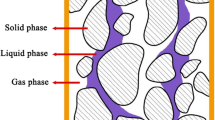Abstract
Radium, which is naturally present in many rocks, decays to the radioactive gas radon, which is exhaled from the surface of underground tunnels and air-raid shelters and is a major source of human exposure to radioactivity. We developed a mathematical model for the migration of radon from a finite-thickness circular tubular emanation medium and a semi-infinite hollow cylindrical emanation medium based on the seepage–diffusion migration theory of radon in porous emanation media. We obtained an analytical solution for the distribution of radon concentration and a formula for the radon exhalation rate under steady-state conditions. When there was no seepage, the radon exhalation rate in the covering layer decreased as the thickness of the covering layer increased and tended toward zero. The radon exhalation rate from the covering layer increased as the radon diffusion coefficient increased. When seepage occurred, the difference in the radon exhalation rate between seepage and non-seepage decreased as the thickness of the covering layer increased. When v > 0, the radon exhalation rate in the covering layer increased as the seepage velocity increased. When v < 0, the radon exhalation rate in the covering layer decreased as the seepage velocity increased.







Similar content being viewed by others
References
World Health Organization. WHO Handbook on Indoor Radon: a Public Health Perspective (Geneva: WHO Press) (2009)
J Ferlay, P Autier, M Boniol, M Heanue, M Colombet and P Boyle Ann. Oncol. 18 581 (2007)
J Chen, N M Rahman and I A Atiya J. Environ. Radioact. 101 317 (2010)
E Lespukh, P Stegnar, A Usubalieva, A Solomatina, B Tolongutov and R Beishenkulova J. Environ. Radioact. 123 28 (2013)
Y Ishimori, K Lange, P Martin, Y S Mayya and M Phaneuf Measurement and calculation of radon Releases from Norm Residues. Technical reports series No. IAEA, Vienna, 474 (2013)
S Turhan, U N Baykan and K Sen J. Radiol. Prot. 28 83 (2008)
K Kovler Constr. Build. Mater. 23 246 (2009)
V C Rogers and K K Nielson Health Phys. 61 225 (1991)
V S Yakovleva, I Roman and Parovik Nukleonika 55 601 (2010)
W E Clements and M H Wilkening J. Geophys. Res. 79 5025 (1974)
J Leung and M L Tso Health Phys. 77 420 (1999)
B K Sahoo, Y S Mayya and B K Sappa Radiat. Meas. 45 237 (2010)
B K Sahoo, B K Sappa and J J Gaware Sci. Total Environ. 409 2635 (2011)
S D Schery, D H Gaeddert and M H Wilkening J. Geophys. Res. 87, 2969 (1982)
V C Rogers and K K Nielson Health Phys. 60 807 (1991)
P Sahu, D P Mishra, D C Panigrahi, V Jha, R L Patnaik and N K Sethy J. Environ. Radioact. 130 15 (2014)
R Garra and E Salusti Physica D 250 52 (2013)
K J Renken and T Rosenberg Health Phys. 68 808 (1995)
S G Cui, P Liu, E Q Cui, J Su and B Huang Constr. Build. Mater. 173 124 (2018)
C Lian, Y Zhuge and S Beecham Constr. Build. Mater. 25 4294 (2011)
Y J Ye, L H Wang, D X Ding, Y L Zhao and N B Fan Radiat. Meas. 68 1 (2014)
Acknowledgements
This Project was supported by National Natural Science Foundation of China (Grant No. 11575080), Hunan Provincial Natural Science Foundation of China (Grant No. 2018JJ2318) and the Graduate innovation subject of University of South China, China (Grant No. 2017YCXXM04).
Author information
Authors and Affiliations
Corresponding author
Electronic supplementary material
Below is the link to the electronic supplementary material.
Rights and permissions
About this article
Cite this article
Ye, Y.J., Wu, W.H. & Huang, C.H. Theoretical study of the exhalation of radon from a circular tubular cover layer. Indian J Phys 93, 667–672 (2019). https://doi.org/10.1007/s12648-018-1327-9
Received:
Accepted:
Published:
Issue Date:
DOI: https://doi.org/10.1007/s12648-018-1327-9




